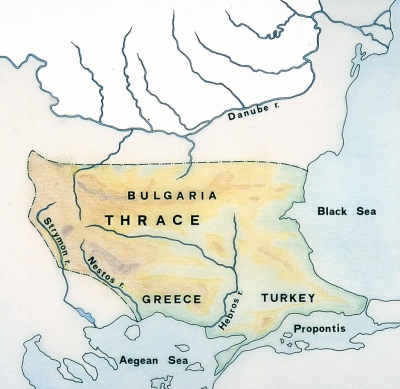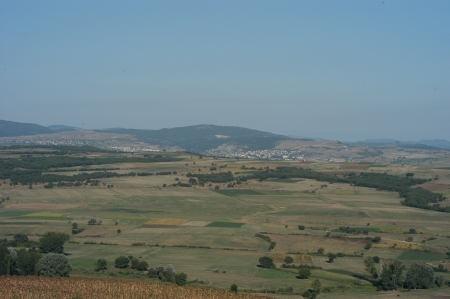Aegean Thrace, consisting of Rhodope, the Nestos and the Evros, (the present day Greek Thrace), is a small part of the large area of ancient Thrace. This originally extended from the Aegean coast to the Hellespont and Bosphorus, north to the Danube (Istros) and from the coast of the Black Sea to neighbouring Macedonia. Northern Thrace today belongs to Bulgaria and eastern Thrace to Turkey.
Its geographical position between Europe and Asia and the major roads, which traversed its plains and mountains, have all defined the long historical development of Thrace. Its rich vegetation, forests, rivers and abundant water encouraged the presence of man in the region as early as the Palaeolithic period (around 40000 years ago).
In the 11th century BC, Thracian tribes of Indo-European descent, who migrated from the northern and central areas of Europe, settled principally in the mountains and plains of Thrace from the Aegean to the Danube. A few tribes reached Asia Minor and the islands of the northern Aegean. In the 7th century BC, with the foundation of Greek colonies on the Aegean coast and the Black Sea, relations between the Greeks and the Thracians developed and remained strong throughout the historical period.
 In AD 46 when Claudius was emperor, Thrace became a Roman Province.
Until the time of Trajan, (AD 98-117), the area was divided into
strategiae (large districts) and had a curator as governor.
Trajan instigated changes in the administrative system and promoted
the urbanisation of the area, founding a series of important cities
such as Trajanopolis, Plotinopolis, Augusta Traiana etc. Later,
Hadrian founded Hadrianopolis at the confluence of three rivers, the
Evros, Tonzos and Ardas. The cities along with their region, (the
surrounding region where the dependent villages were located),
progressively replaced the military districts. There were no
significant Imperial possesions in Thrace and ownership remained
in the hands of the indigenous population. The economy of the area
was based largely on stock-breeding and the exploitation of the
abundant natural resources. The basic focus of agricultural life was
the vicus (village). Evidence of the prosperity of the farmers of
Thrace is known from excavations, chiefly in Bulgaria, where large
rural villas and tombs with rich grave-goods, which probably belonged
to the wealthy local landowners, have been uncovered.
In AD 46 when Claudius was emperor, Thrace became a Roman Province.
Until the time of Trajan, (AD 98-117), the area was divided into
strategiae (large districts) and had a curator as governor.
Trajan instigated changes in the administrative system and promoted
the urbanisation of the area, founding a series of important cities
such as Trajanopolis, Plotinopolis, Augusta Traiana etc. Later,
Hadrian founded Hadrianopolis at the confluence of three rivers, the
Evros, Tonzos and Ardas. The cities along with their region, (the
surrounding region where the dependent villages were located),
progressively replaced the military districts. There were no
significant Imperial possesions in Thrace and ownership remained
in the hands of the indigenous population. The economy of the area
was based largely on stock-breeding and the exploitation of the
abundant natural resources. The basic focus of agricultural life was
the vicus (village). Evidence of the prosperity of the farmers of
Thrace is known from excavations, chiefly in Bulgaria, where large
rural villas and tombs with rich grave-goods, which probably belonged
to the wealthy local landowners, have been uncovered.
The characteristic conical and hemispherical built mounds, are a prominent feature of the varied Thracian landscape. With their variety of size and shape, they have for centuries contributed harmoniously to the character of the natural landscape. Many of these are located in northern Thrace, while there are plenty in eastern and south-western Greek Thrace. The majority of the tumuli of Greek Thrace are concentrated in the northern part of the Prefecture of Evros, especially in the area of Orestiada and Trigono. The tumuli, as large burial monuments, were built in conspicuous locations, on natural heights or in open plains, with the intention of being seen by all who passed through the major and minor roads of the region. The earliest tumuli date to the Bronze Age. The tradition of built tumuli continued into the historical period, as much amongst the inhabitants of the Greek cities on the coast as the inhabitants of the hinterland. In the Roman period, especially the first two centuries AD, the tradition of constructing tumuli was very prevalent in the area of Thrace. These tumuli covered different types of grave. In the majority of the tumuli, which have been excavated in the area of northern Evros and which date to the Roman period, the deceased were cremated. Logs of wood were arranged in large pits cut into the ground; on top of these, the wooden bier carrying the body of the deceased, was placed. Small animals, such as piglets, birds or fruit (walnuts, almonds and pine nuts) were thrown into the fire. When the fire had died down the personal possessions of the deceased (weapons, jewellery etc.) were arranged around the body with vessels full of offerings (milk, water, wine, honey or food). The pits were then filled with earth and a built mound, frequently of considerable size, was raised over them. Its construction was the work of many days and great expense. On a few occasions, when the cremation took place at another location outside the area of the tumulus, the ashes were brought and placed in the mound or in cinerary urns. Frequently members of the same family were buried in the same tumulus, which gradually increased in size to cover the new graves.
 The tumulus of Mikri Doxipara-Zoni was built in the western
part of the Eparchy of northern Evros in an area which is
situated between Mikri Doxipara, Zoni and Chelidona and is
under the jurisdiction of the municipality of Kyprinos With
a diameter of 60m and a height of 7.5m it was one of the largest
tumuli in the area. For its construction a natural hill was
chosen so that the tumulus would be visible from far away.
From the tumulus the view stretches, uninterrupted, to the
mountains of Bulgarian Thrace opposite and towards Kyprino and
Arda. It was built in stages at the beginning of the 2nd century
AD to cover the cremation burials of four members of a family
who died in succession. Beside the pits, which contained the
remains of the cremation and the grave goods, were buried the
five wagons which had brought them to this location along with
their draft teams and a further five horses. In various parts
of the tumulus, broken vessels, ashes and animal bones were
found, the remains of rituals which took place in honour of the
dead during the course of construction of the tumulus. A large
number of small vessels containing offerings to the dead were
found placed on two brick-built platforms, while two pit-hearths
were also found filled with ash.
The tumulus of Mikri Doxipara-Zoni was built in the western
part of the Eparchy of northern Evros in an area which is
situated between Mikri Doxipara, Zoni and Chelidona and is
under the jurisdiction of the municipality of Kyprinos With
a diameter of 60m and a height of 7.5m it was one of the largest
tumuli in the area. For its construction a natural hill was
chosen so that the tumulus would be visible from far away.
From the tumulus the view stretches, uninterrupted, to the
mountains of Bulgarian Thrace opposite and towards Kyprino and
Arda. It was built in stages at the beginning of the 2nd century
AD to cover the cremation burials of four members of a family
who died in succession. Beside the pits, which contained the
remains of the cremation and the grave goods, were buried the
five wagons which had brought them to this location along with
their draft teams and a further five horses. In various parts
of the tumulus, broken vessels, ashes and animal bones were
found, the remains of rituals which took place in honour of the
dead during the course of construction of the tumulus. A large
number of small vessels containing offerings to the dead were
found placed on two brick-built platforms, while two pit-hearths
were also found filled with ash.
Excavation of the wider area around the tumulus has not yet been accomplished. We are not in a position to determine where those who were buried in this tumulus lived. It is known however, from excavations which have been undertaken in northern Thrace, that landowning families who lived on large agricultural estates chose to be buried on family land rather than in centralised cemeteries.
It is suggested that a rich family of landowners who lived in the area at the beginning of the 2nd century AD buried four family members in this location and, after their funerals, constructed a large tumulus to keep the memory of the deceased alive throughout the centuries.
